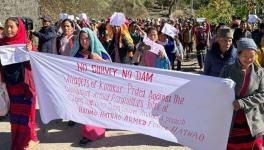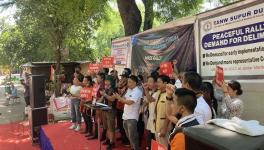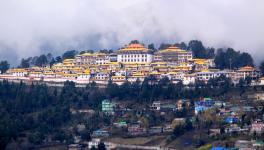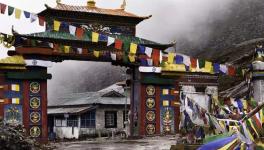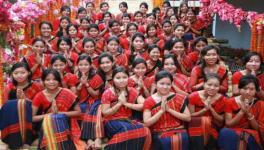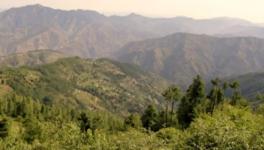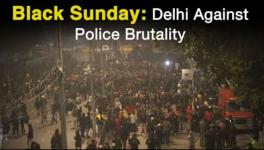The Limits of the Nation States
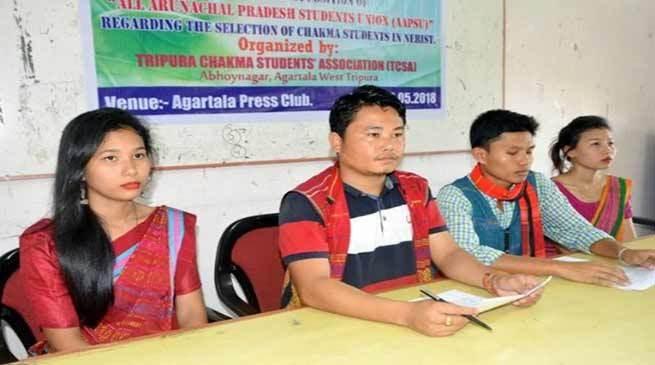
Image Coutesy: NorthEast India 24
The All Arunachal Pradesh Students Union (AAPSU) has demanded the disqualification of all Chakma and Hajong candidates clearing the North East Regional Institute of Science & Technology (NERIST) Entrance Exam, 2018. The student union has stated that the Chakma and Hajong issue has dogged the state since the 1960s and that their admission would affect the academic life of the institute. They also alluded to a similar issue in Mizoram wherein Chakma candidates were placed under category-I reservation for technical seats under the state quota.
The Mizo Zirlai Pawl (MZP) – Mizo Students Union – had opposed this as they claimed that category-I was reserved solely for indigenous Zo people. In Mizoram, category-I reservation for the state quota stands at 85%, the remaining 15% is then divided among categories II and III. The Chakma students, in this case, fought back and succeeded in getting a Gauhati High Court Order in their favour. However, the larger questions here are; who are the Chakmas? And, why are they so despised?
The Chakma people are a minority ethnic community in present-day Bangladesh whose homeland somewhat overlaps with pockets in Mizoram and Tripura. Their traditional homeland lies in what is known as the Chittagong Hill Tracts (CHT) within which they constitute a majority among other smaller ethnic communities. However, though the Chakmas traditionally have resided in the CHT and adjoining hill areas across the international border, there is no place in the world where they can reside in peace. Their problems began with Cyril Radcliffe, who drew the infamous lines partitioning British India.
At the time, the people of the CHT constituted a separate administration under the British. In return for autonomy, their chieftains paid the British taxes. Their exclusion was under a colonial law along the lines of the Bengal Eastern Frontier Regulations – the law restricting entry into Arunachal Pradesh, Nagaland and Mizoram. They shared no similarities with the larger Bengali population and instead are socially, culturally and physically distinct from the Bengalis. Though some of the communities residing in the CHT are ethnically closer to the Mizos and 'tribal' Tripuris, while others are closer to the Arakanese. At the time of partition, their chieftains visited Nehru and appealed to be included within Indian territory. Nehru, on his part, forwarded their requests to the Boundary Commission. These requests were evidently denied. Mountbatten allegedly opposed this idea on two counts. Firstly, because Calcutta had been given to India, and Chittagong being the only other port should be awarded to Pakistan. The other reason was that the CHT was inaccessible from the Indian side. The latter reason is superficial as anybody travelling through Tripura can affirm, there are points where the road winds across the border, meaning that in some instances one has to pass through Bangladesh to get to another place in Tripura.
Thus the people of the CHT were unwillingly co-opted into a country they did not wish to be a part of. From around this time, the government of Pakistan eroded the law granting the CHT autonomy. Thus began a spate of settling migrants into the hill tracts. The situation was aggravated in the 1960s when the Kaptai hydro-electric project was commissioned. The dam submerged the lands of the hill people. Here is the important note, the people of the CHT are – somewhat derogatorily – collectively referred to as jumias or jummas. This is a direct reference to the shifting cultivation almost all the communities practice. Thus, when forest land is submerged, their agricultural land is submerged too. The displaced people in this instance were predominantly Chakma and they did not receive any compensation either as land or money. The displaced Chakmas then trekked across the hills to India where they landed up in Tripura. Nehru who was the PM at the time agreed to take them in, but did not see it fit to settle them in Tripura, which is a land-stressed state. Instead, he opted to settle them in the North East Frontier Agency (NEFA) whose administration at the time was handled by the Ministry of External Affairs. The idea was that following the 1962 debacle, the Chakmas would return their gratitude to India by supporting the country in any future conflict with China.
However, this optimism has today become a bone of contention in Arunachal Pradesh. The people of Arunachal Pradesh rightly claim that they were never consulted before the Indian government unilaterally assigned land owned by the local communities to the Chakmas without any compensation. The other complication, however, was not the few thousand families who were settled in one of the most remote and inaccessible parts of Arunachal Pradesh, but the ones who followed. The situation in East Pakistan began to grow increasingly hostile, not only towards the people of the CHT, but also to the Bengalis. The result was the Liberation War. After the war, two major incidents occurred. First was the Indira-Mujib Pact wherein all those who entered India from East Pakistan before March 25, 1971, would be treated as Indian citizens and the rest would be Bangladeshi citizens. The other was that a delegation of representatives from the CHT approached the Sheikh Mujibur Rehman government seeking autonomy for the CHT as well as reintroducing the colonial law. Mujibur Rehman refused. These two incidents spawned their own set of problems.
The Indira-Mujib Pact sealed the fate of the Chakmas settled in Arunachal Pradesh. Though they had never been officially recognised as refugees, they would become eligible for citizenship. On the other hand, Mujibur Rehman's dismissal of the CHT delegation set the stage for antagonistic relations between Dhaka and the hills. The Government of Bangladesh under Rehman took an assimilative approach. The Constitution at the time had declared the nationality of all citizens as Bengali, and the language as Bangla. There was no scope for compromise. The government further resumed the policies of Pakistan in settling people in the CHT. In this scenario a political party was formed in the hills, the – Parbatya Chattagram Jana Sanghati Samiti (PCJSS) (United Peoples Organisation of the Chittagong Hill Tracts). M. N. Larma of the PCJSS contested the general elections and won. He voiced the demand of autonomy in the parliament for the CHT, however, his appeals were unheeded. He later began an armed movement for an independent Jummaland under the aegis of the Shanti Bahini. The ensuing conflict once again displaced people en masse. The state repression spearheaded by the Bangladesh Army saw summary executions, torture and rape become the norm. The people were herded into camps, those that could flee did so. Thus, another round of refugees trickled into India. Many opted to join those who were settled in Arunachal Pradesh following the Kaptai dam displacement.
In Mizoram, the situation is not only different, but more complicated. The Chakmas had assisted the British as coolies and labourers during their expeditions in the Lushai Hills – now Mizoram –, many had been rewarded with being allowed to settle there. On one hand, it is plausible that there may have been some bordering pockets of Mizoram which were considered 'Chakma territory', however, the bulk of the Chakma residents came during colonial rule. Several colonial administrators later adopted policies to restrict and evict new Chakma arrivals. However, the Shanti Bahini insurgency may have also caused more inflows of Chakmas into Mizoram. Though the insurgency ended in 1997 when the Shanti Bahini surrendered and entered into an agreement with the government of Bangladesh, the policies of repression and settling outsiders into the CHT continued. Thus, it is unlikely that 1997 agreement created an atmosphere for repatriation.
The problem now arises over what the solution should entail. Clearly, the Chakma issue is not one to be resolved within India. Despite a Supreme Court Judgement, decisions of the Gauhati High Court, as well as the Delhi High Court, regarding their citizenship and civil rights, nothing has been done on that front in Arunachal Pradesh. In Mizoram, despite having an Autonomous District Council (ADC), the ADC itself is starved of funds by the state government. Thus, it appears that no constitutional organ is capable of enforcing the rights of the Chakmas. On the other hand, the local sentiments of the host communities also should be taken into consideration.
Short of redrawing borders, the only options available are to either formulate a convoluted policy for the Chakmas in Arunachal Pradesh granting them citizenship with limited rights – even Indian citizens cannot own land in Arunachal Pradesh unless they belong to the 'tribal' communities. As well as another convoluted policy for Mizoram, placing the funds for their ADC under the governor rather than the state government. The other option is to bring Bangladesh on board to repatriate the Chakmas in the CHT. This, however, is undoable keeping several geopolitical considerations in mind. Firstly, Bangladesh is unlikely to even consider those found to be foreigners through the NRC process as their citizens, even if they are Bengali. Secondly, considering that land grabbing in the CHT continues unabated under the watchful eye of the Bangladesh army, repatriating them in their ancestral land is also unlikely. Thirdly, the Rohingya issue with Myanmar has Bangladesh now requesting India to pressure Myanmar into repatriating the Rohingyas, signalling Dhaka's unwillingness to accept refugees. Finally, the Indian security establishment is unwilling to push their luck with their neighbours as the China card has become increasingly popular.
Thus, India is in an unenviable position, wherein what was sown at the time of partition is beginning to emerge as a humanitarian crisis.
Get the latest reports & analysis with people's perspective on Protests, movements & deep analytical videos, discussions of the current affairs in your Telegram app. Subscribe to NewsClick's Telegram channel & get Real-Time updates on stories, as they get published on our website.









